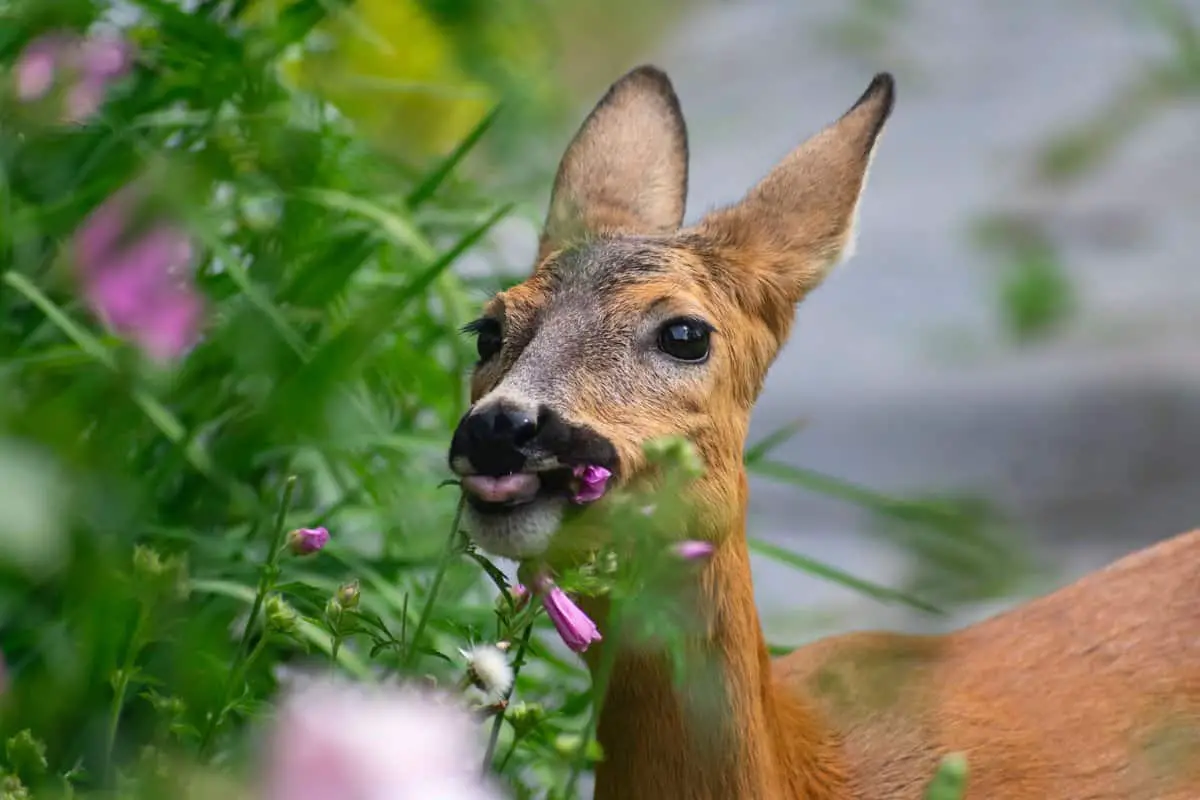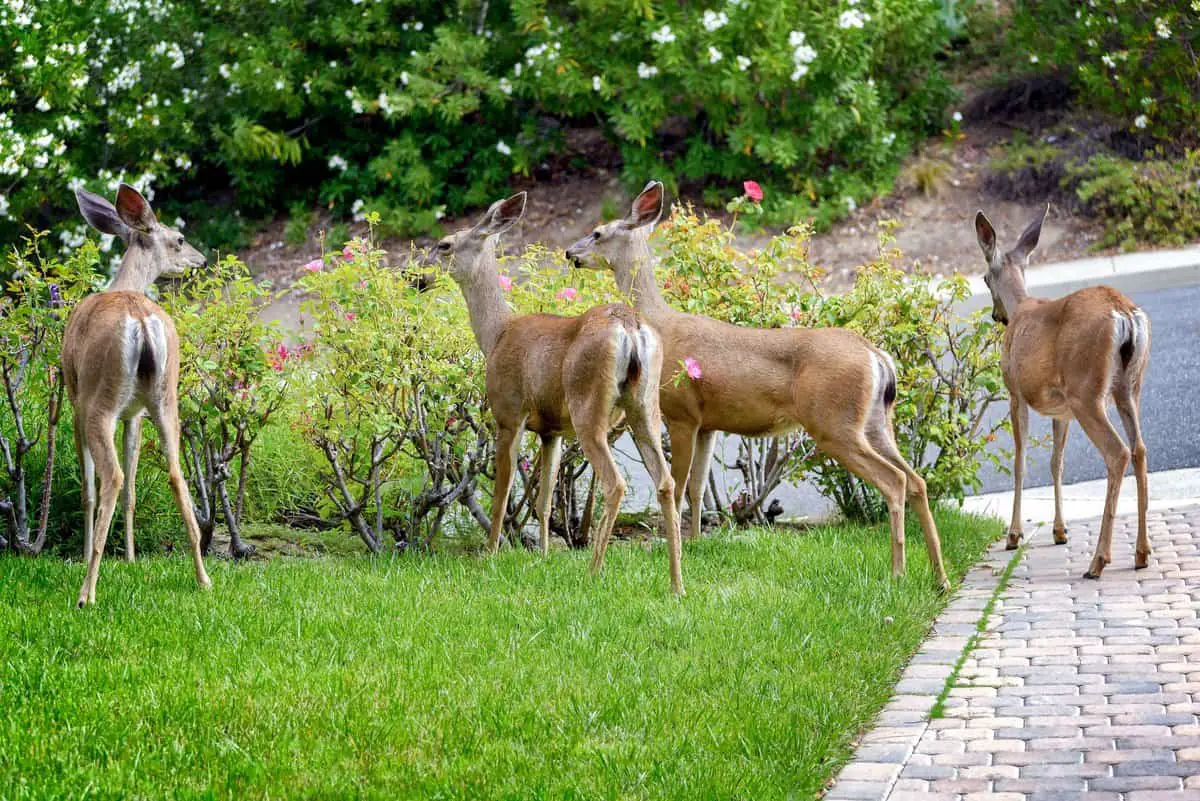Do deer eat hostas? If you live around these critters and love your hostas whole and intact, this is an important question to know the definitive answer to.
Will you catch deer eating hostas? The answer is yes. For deer, consider hostas to be like candy. Some hosta marketing claims that certain species have a degree of deer resistance.
But, with all plants that are supposedly deer-resistant, deer will eat anything when they get hungry enough.
If you see a deer heating hostas, this can be extremely frustrating. But, you don’t always see them. Instead, you come out to deer damaged plants and have no clue who the culprit is.
We’ll give you clues that you can use to see if it’s deer or something else eating your hosta plants. Read on to find out more!
Are Hostas Deer Resistant?
If you have hostas and you live in an area with deer, you may have planted the hostas because someone told you they were deer resistant. But is it true? Unfortunately, I found out the hard way that there is no such thing as a deer resistant hosta.
However, there is a bright spot. For gardeners battling a deer invasion, you should know that there are some hosta species that rate much higher on the culinary ladder than other species for deer. But, if the deer are hungry, any hosta will do.
Knowing which hostas deer prefer over others can help you pick out your hostas that could stand a slightly better chance of being left alone.
Since only artificial hostas are 100% deer-proof, the following are species you want to avoid if you’re worrying about deer damage. To date, there are over 270 fragrant hostas in existence, with the Stained Glass hostas being very popular.
You can purchase them in the spring, but many people choose to buy them when they bloom because of the fragrance. However, this is exactly what attracts deer.

The second type of hosta that draws deer is the non-variegated hostas. This is just a fancy way of saying that the hostas are green instead of green and yellow or green and white.
So, you want to plant variegated hostas that have yellow, gold, blue, cream, or white in their leaves. The leaves can have stripes, blotches, or solid patterns to them. As a bonus, these types of hostas can add focal points to your garden.
Do Deer Eat Hosta Flowers?
Yes, the more fragrant hosta flowers will actually attract deer to your hosta garden. They prefer the leaves, but they’ll eat the flowers too. Therefore it’s so common to come out and find your hostas eaten right down to the ground when deer get at them.
This can be extremely frustrating because you can go from having huge and lush hostas one day to have nubs the next if the deer feed aggressively enough.
Video: How to Keep Deer out of Your Yard in Every Season
Five Telltale Signs Deer Are Eating Hostas
Luckily, you can look around and get a good idea on whether the deer have been in your hostas. There are several telltale signs you can check for in your yard and around your hostas. If you see them, you can safely assume deer are eating your hostas.
1. Ragged Plant Stalks
One of the first and biggest indicators that you have a deer problem is you’ll end up with ragged plant stalks. Deer are very destructive to hostas, and the visual evidence can be startling if you’ve never seen it before.
Deer can take a healthy hosta with large leaves and strong stalks and turn it into a ragged shadow of its former self. The deer will eat the leaves right down to the stalks, and they may leave bite marks on the stalks themselves.
If you have flowers on your hostas, those will usually disappear too.
2. High Up Plant Damage
It may surprise you to know, but deer can damage plants as high as five to six feet up. This means your giant hostas aren’t even safe from there if they’re hungry enough.
Deer are relatively tall as a general rule, so it’s easier for them to reach over and up to eat the top parts of plants like hostas than it is for them to bend down. You may notice that the tops of your hostas are gone instead of the pieces close to the ground.
3. Deer Hoof Prints or Holes in the Soft Ground
Since hostas like a lot of water, it makes sense that the ground will be soft. When the deer step on the ground to get to your hostas, they’ll leave a lot of prints.
Deer prints are easy to identify because deer have two elongated, cloven, divided toes on each foot. Each hoof also has two smaller dew claws that are behind and above the foot.
4. Deer Droppings
Deer droppings are another good sign of deer eating hostas. Since deer tend to go wherever they’re standing, you should see droppings around your hostas because they’ll go as they eat.
Deer droppings are usually small hard, spherical shapes. You want to get rid of these droppings because they can attract other pests, like rats.
5. Trampled Plants
Deer aren’t careful as they walk around and through your plants, and this can cause trampled hostas. If this happens, you’ll have damage all over the plant. You could see leaves with holes in them or snapped off plant stalks.
The trampled parts of your hosta will die, so it’s a good idea to remove them. This also removes more temptation for the deer to come back.

Frequently Asked Questions
After Deer Eat Hostas, Will They Grow Back
As long as the deer leave some stems behind and it’s early in the growing season, you could see some leaves come back. However, the leaves most likely won’t come back as big as your original leaves were, but the plant will survive to come back bigger than ever next season.
Which Hostas Are More Vulnerable to Deer Eating Them
Hostas that have fragrant flowers and hostas that are non-variegated or green with no swirls of other colors are the most vulnerable. People believe that the fragrance from the flowers attracts the deer to your hosta garden.
What Should You Do with Hostas After Deer Eat Them
This depends on what they leave after getting into them. If there are stems left, you can trim away any partially eaten portions and let them grow back. Another option is to replant them in containers and bring them indoors to grow.
You can also transplant them to outdoor containers and put them out of reach of the deer, so five or six feet up at a minimum.
Final Thoughts
If you have a problem with deer eating hostas, don’t despair. Hostas are very hardy plants that come back year after year. Remember, there’s no such thing as a deer-proof hosta unless it’s an artificial one.
Look for the telltale signs that deer are eating your hostas like ragged plant stalks, high up damage, hoof prints, trampled areas, and droppings.
Once you find out if it’s deer or not in your hostas, you can take proactive steps to protect your plants so they stay lush and green all season.

